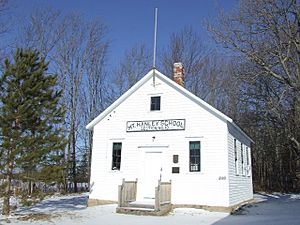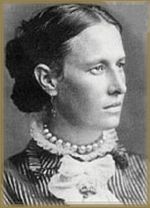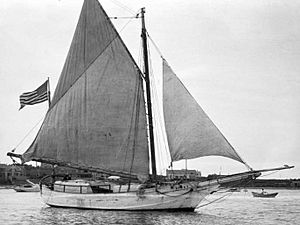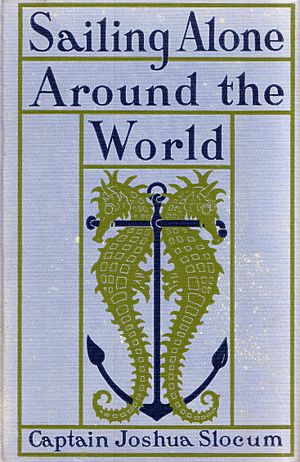Joshua Slocum facts for kids
Quick facts for kids
Joshua Upham Slocum
|
|
|---|---|

From The Century Magazine, Sept. 1899
|
|
| Born |
Joshua Upham Slocombe
February 20, 1844 Mount Hanley, Nova Scotia
|
| Disappeared | November 14, 1909 (aged 65) At sea |
| Nationality | Canadian (by birth, Nova Scotia – 1869) naturalized US citizen |
| Known for | First solo circumnavigation of the world (1895–1898) |
| Spouse(s) | Virginia Albertina Walker (m. 1871-1884), Henrietta Slocum (m. 1886-1909) |
| Children | Victor Slocum Benjamin Slocum Jessie Slocum James Slocum |
| Parent(s) | John Slocombe Sarah Southern |
| Relatives | Henrietta Slocum |
Joshua Slocum (born February 20, 1844 – disappeared on or after November 14, 1909) was an amazing sailor and adventurer. He was the first person to sail all the way around the world by himself. Born in Nova Scotia, Canada, he later became an American citizen.
In 1900, he wrote a famous book about his journey called Sailing Alone Around the World. This book became a huge success around the world. Joshua Slocum disappeared in November 1909 while sailing his boat, the Spray.
Contents
Joshua Slocum's Childhood in Nova Scotia
Joshua Slocum was born on February 20, 1844, in Mount Hanley, Annapolis County, Nova Scotia. This community was located on the North Mountain, where he could see the Bay of Fundy. He was the fifth of eleven children. His family had moved to Nova Scotia from the United States.

Joshua learned to read and write at the nearby Mount Hanley School. His first experiences on the water were on small ships called schooners. These ships sailed from ports like Port George and Cottage Cove, close to Mount Hanley.
When Joshua was eight, his family moved to Brier Island. His grandfather was the lighthouse keeper there. Joshua's father made leather boots, and Joshua helped him. But Joshua loved the smell of the ocean more than the smell of leather. He dreamed of an adventurous life at sea.
He tried to run away from home several times. Finally, at age fourteen, he succeeded. He got a job as a cabin boy and cook on a fishing schooner. However, he soon returned home. In 1860, after his mother passed away, sixteen-year-old Joshua left home for good. He and a friend signed on as sailors on a merchant ship going to Ireland.
Early Adventures at Sea
From Ireland, Joshua went to Liverpool, England. There, he became a sailor on a British merchant ship called the Tangier. This ship was headed for China. For two years, he sailed around Cape Horn twice. He visited many places like Jakarta, the Maluku Islands, Manila, and San Francisco.
While at sea, he studied hard. At just eighteen years old, he earned his certificate as a qualified Second Mate. Slocum quickly moved up the ranks. He became a Chief Mate on British ships. These ships carried coal and grain between Britain and San Francisco.
In 1865, he settled in San Francisco and became an American citizen. After some time fishing for salmon and trading furs, he returned to the sea. He became a pilot for a schooner sailing along the coast between San Francisco and Seattle. In 1869, he got his first command of a large ship. It was a barque called the Washington. He sailed it across the Pacific Ocean to Australia and back home through Alaska.
For thirteen years, he sailed out of San Francisco. He carried different goods to China, Australia, and Japan. Between 1869 and 1889, he was the captain of eight different ships. He owned some of these ships himself.
Family Life on the Ocean
In late 1870, Slocum's ship, the Washington, arrived in Sydney, Australia. There, he met and married Virginia Albertina Walker. Their wedding was on January 31, 1871. Virginia was an American whose family had moved to California during the California Gold Rush. They later sailed to Australia.
Virginia sailed with Slocum. Over the next thirteen years, they had seven children. All of them were born at sea or in foreign ports. Four of their children, Victor, Benjamin Aymar, James Garfield, and Jessie, lived to be adults.
In Alaska, the Washington was damaged in a storm. Slocum, risking his own safety, managed to save his wife, the crew, and much of the cargo. He brought everyone back to port safely using the ship's small boats. The shipping company was so impressed by his skill that they gave him command of another ship, the Constitution. He sailed this ship to Hawaii and Mexico.
His next command was the Benjamin Aymar. However, the ship's owner sold it, leaving Slocum and Virginia without a ship in the Philippines.
Building the Pato
While in the Philippines in 1874, Slocum helped build a 150-ton steamer. As part of his payment, he received a ninety-ton schooner called the Pato. This was the first ship he truly owned.
Owning the Pato gave Slocum a new sense of freedom. He hired a crew and delivered cargo to Vancouver, Canada. After that, he used the Pato to carry goods along the west coast of North America and between San Francisco and Hawaii. During this time, Slocum also started writing. He became a temporary reporter for the San Francisco Bee newspaper.
The Slocums sold the Pato in Hawaii in 1878. They returned to San Francisco and bought another ship, the Amethyst. He worked with this ship until 1881.
They then bought a share in a large clipper ship called the Northern Light 2. This ship was 233 feet long and could carry 2000 tons of cargo. Slocum called it "my best command." However, this ship had many problems, including issues with the crew. Slocum sold his share in the Northern Light 2 in 1883.
The Aquidneck and New Challenges
The Slocum family continued their voyages on their next ship, the 326-ton Aquidneck. In 1884, Slocum's wife, Virginia, became sick while aboard the Aquidneck in Buenos Aires and sadly passed away. After sailing to Massachusetts, Slocum left his three youngest children with his sisters. His oldest son, Victor, continued to sail with him as his first mate.
In 1886, Slocum, then 42, married his 24-year-old cousin, Henrietta "Hettie" Elliott. The Slocum family, except for Jessie and Benjamin Aymar, went back to sea on the Aquidneck. Henrietta found life at sea much harder than Virginia had. Their first voyage included a hurricane. Later, the crew got sick with cholera, and they were quarantined for six months. Slocum also had to defend his ship from pirates. The Aquidneck was later infected with smallpox, and three crew members died. Near the end of 1887, the Aquidneck was wrecked in southern Brazil.
Building the Liberdade
After being stranded in Brazil, Slocum decided to build a new boat to sail his family home. He used local materials and parts salvaged from the wrecked Aquidneck. He worked with local people to build the boat. It was launched on May 13, 1888, the same day slavery ended in Brazil. So, he named the ship Liberdade, which means "freedom" in Portuguese.
It was an unusual 35-foot boat with a special type of sail. He described it as "half Cape Ann dory and half Japanese sampan." He and his family began their journey back to the United States. His son Victor, who was 15, was his mate.
After fifty-five days at sea and sailing 5510 miles, the Slocums reached South Carolina. They continued inland to Washington D.C. for the winter. Finally, they reached Boston in 1889. This was the last time Henrietta sailed with the family. In 1890, Slocum wrote about these adventures in his book Voyage of the Liberdade.
The Destroyer Voyage
In the winter of 1893-1894, Slocum took on a very difficult voyage. He had to deliver a steam-powered torpedo boat called the Destroyer from the eastern United States to Brazil.
The Destroyer was a 130-foot warship. It was designed to fire early torpedoes. Brazil was facing a civil war at the time, and Slocum agreed to deliver the ship to the Brazilian government. He hoped to earn money and perhaps get revenge on an admiral who had once treated him badly.
Slocum and a small crew left New Jersey on December 7, 1893. The very next day, the ship began taking on water. The crew had to constantly pump and bail water to keep the ship afloat. They faced storms and rough seas. The ship's rudder broke, and the main part of the Destroyer was sinking. The crew had to keep bailing water to survive, as the ship was not insured.
By December 16, the storm calmed, and they anchored near Puerto Rico. After repairs in Martinique, they set sail again on January 5, 1894. On January 20, they finally reached Recife, Brazil. Slocum said this voyage was much harder than his trip home on the Liberdade.
In Brazil, the Destroyer joined the Brazilian navy. More repairs were needed because the long tow had caused leaks. After more problems and repairs, the ship was eventually taken by the Brazilian navy. It was later damaged and abandoned.
The Spray: Sailing Alone Around the World
Slocum spent a lot of time rebuilding a 36-foot oyster boat named Spray in Massachusetts. He worked on it during 1891 and 1892. On June 21, 1892, he launched his carefully rebuilt vessel.
On April 24, 1895, he began his famous journey from Boston, Massachusetts.
After visiting his childhood home in Nova Scotia, Slocum officially left North America on July 3, 1895. He sailed from Sambro Island Lighthouse near Halifax.
Slocum had planned to sail eastward around the world through the Suez Canal. But when he reached Gibraltar, he realized that sailing through the southern Mediterranean Sea would be too dangerous. There were still pirates in that area. So, he decided to sail westward, through the southern hemisphere. He headed to Brazil and then to the Strait of Magellan. A storm kept him from crossing the Pacific for forty days. Eventually, he made his way to Australia. He then sailed north along its east coast, crossed the Indian Ocean, and rounded the Cape of Good Hope. From there, he headed back to North America.
Slocum navigated without a special clock called a chronometer. Instead, he used an old method called dead reckoning to find his position. This only needed a simple clock for approximate time. He also used the sun at noon to find his latitude. On one long trip in the Pacific, he even used a very old method called lunar distance to check his longitude. This method was rarely used anymore.
Slocum often sailed the Spray without touching the steering wheel. Because of its design, the Spray could steer itself. He balanced the sails and tied the helm in place. He sailed 2000 miles across the Indian Ocean without once touching the steering wheel!
More than three years later, on June 27, 1898, he returned to Newport, Rhode Island. He had sailed around the world, covering over 46,000 miles (74,000 km). Slocum's return was barely noticed at first. The Spanish–American War had just begun, and it was in all the news. After the war ended, many American newspapers finally wrote about Slocum's amazing adventure.
Sailing Alone Around the World
In 1899, Slocum published his story of the voyage in Sailing Alone Around the World. It first appeared in The Century Magazine and then as a book. People loved his adventure story. One reviewer even said, "Boys who do not like this book ought to be drowned at once." Another famous writer called it "the most extraordinary book ever published."
Slocum's book deal was important for his journey. His publisher gave him many books to read on board. Slocum wrote letters to his editor from different places around the world. His book made him very famous in English-speaking countries. He was even invited to a special dinner honoring the famous writer Mark Twain in 1900. Slocum also sailed the Spray up the Erie Canal to Buffalo, New York, for the Pan-American Exposition in 1901. He earned good money from being part of the fair.
Later Life and Disappearance
In 1901, the money from Slocum's book and his public talks allowed him to buy a small farm. It was in West Tisbury, Massachusetts, on the island of Martha's Vineyard. After about a year and a half, he found he couldn't get used to a settled life. He preferred to sail the Spray from port to port. He would sail in the northeastern US during the summer and in the West Indies during the winter. He gave lectures and sold his books wherever he went. Slocum spent little time at his farm and preferred life on the Spray.
Slocum and the Spray visited Sagamore Hill, the home of US President Theodore Roosevelt. Roosevelt and his family were very interested in Slocum's stories of sailing around the world. The President's young son, Archie, even spent a few days sailing with Slocum. Slocum met President Roosevelt again in 1907 at the White House. Roosevelt reportedly told him, "Captain, our adventures have been a little different." Slocum replied, "That is true, Mr. President, but I see you got here first."
By 1909, Slocum's money was running low. Book sales had decreased. He planned to sell his farm and start a new adventure in South America. He hoped to write another book.
On November 14, 1909, Slocum set sail in the Spray from Vineyard Haven, Massachusetts. He was heading for the West Indies, as he often did in winter. He also wanted to explore the Orinoco, Rio Negro, and Amazon Rivers. Joshua Slocum was never seen or heard from again. In July 1910, his wife told newspapers that she believed he was lost at sea.
Even though he was a very experienced sailor, Slocum never learned to swim. He thought it was useless. In 1924, Joshua Slocum was officially declared dead.
Slocum's Legacy
Joshua Slocum's achievements have been widely recognized and honored. The name Spray has become popular for cruising yachts ever since his book was published. Many people have built their own versions of the Spray based on the plans in Slocum's book.
The French long-distance sailor Bernard Moitessier named his 39-foot boat Joshua to honor Slocum. Moitessier sailed this boat from Tahiti to France. He also used Joshua in a famous race around the world in 1968. He was doing well but decided to leave the race and sail on to the Polynesian Islands instead.
Ferries named Joshua Slocum and Spray served routes in Nova Scotia between 1973 and 2004. The Joshua Slocum ferry was even featured in a movie.
An underwater glider—a robot submarine—designed by the Scripps Institution of Oceanography was named after Slocum's ship Spray. It was the first robot submarine to cross the Gulf Stream. Another robot submarine was named after Slocum himself: the Slocum Electric Glider.
In 2009, a Slocum glider, changed by Rutgers University, crossed the Atlantic Ocean in 221 days. It traveled from New Jersey to Spain. Like Slocum, these gliders can travel thousands of kilometers. Scientists still use these gliders to explore the Gulf of Mexico and other bodies of water.
A monument to Slocum stands on Brier Island, Nova Scotia, near where his family's boot shop used to be. He is also remembered in museum exhibits. These include the New Bedford Whaling Museum in Massachusetts and the Maritime Museum of the Atlantic in Nova Scotia. The Mount Hanley Schoolhouse Museum near his birthplace also has exhibits about him. Several books have been written about Slocum's life.
The Slocum River in Massachusetts was named for him. A new plant discovered in Mauritius was also named "Slocum" in his honor. Slocum himself accidentally discovered an island and named it Alan Erric Island.
In 2011, Joshua Slocum was inducted into the National Sailing Hall of Fame.
See also
 In Spanish: Joshua Slocum para niños
In Spanish: Joshua Slocum para niños
- Harry Pidgeon, the first person to sail alone around the world using the Panama Canal.
- List of people who disappeared at sea





